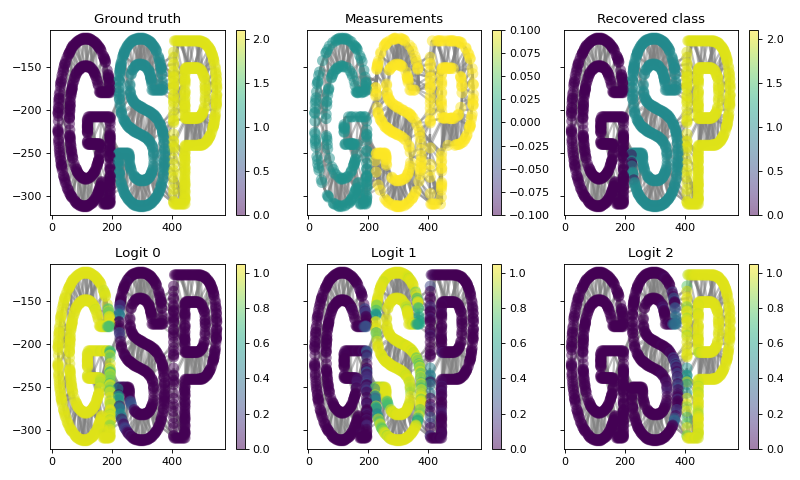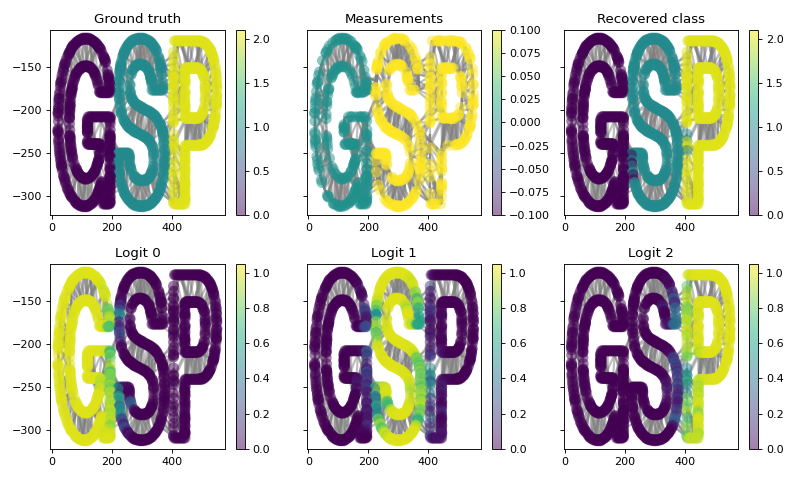Learning¶
The pygsp.learning module provides functions to solve learning problems.
Semi-supervized learning¶
Those functions help to solve a semi-supervized learning problem, i.e., a problem where only some values of a graph signal are known and the others shall be inferred.
|
Solve a regression problem on graph via Tikhonov minimization. |
|
Solve a classification problem on graph via Tikhonov minimization. |
|
Solve a classification problem on graph via Tikhonov minimization with simple constraints. |
- pygsp.learning.classification_tikhonov(G, y, M, tau=0)[source]¶
Solve a classification problem on graph via Tikhonov minimization.
The function first transforms \(y\) in logits \(Y\), then solves
\[\operatorname*{arg min}_X \| M X - Y \|_2^2 + \tau \ tr(X^T L X)\]if \(\tau > 0\), and
\[\operatorname*{arg min}_X tr(X^T L X) \ \text{ s. t. } \ Y = M X\]otherwise, where \(X\) and \(Y\) are logits. The function returns the maximum of the logits.
- Parameters
- G
pygsp.graphs.Graph - yarray, length G.n_vertices
Measurements.
- Marray of boolean, length G.n_vertices
Masking vector.
- taufloat
Regularization parameter.
- G
- Returns
- logitsarray, length G.n_vertices
The logits \(X\).
Examples
>>> from pygsp import graphs, learning >>> import matplotlib.pyplot as plt >>> >>> G = graphs.Logo()
Create a ground truth signal:
>>> signal = np.zeros(G.n_vertices) >>> signal[G.info['idx_s']] = 1 >>> signal[G.info['idx_p']] = 2
Construct a measurement signal from a binary mask:
>>> rng = np.random.default_rng(42) >>> mask = rng.uniform(0, 1, G.n_vertices) > 0.5 >>> measures = signal.copy() >>> measures[~mask] = np.nan
Solve the classification problem by reconstructing the signal:
>>> recovery = learning.classification_tikhonov(G, measures, mask, tau=0)
Plot the results. Note that we recover the class with
np.argmax(recovery, axis=1).>>> prediction = np.argmax(recovery, axis=1) >>> fig, ax = plt.subplots(2, 3, sharey=True, figsize=(10, 6)) >>> _ = G.plot(signal, ax=ax[0, 0], title='Ground truth') >>> _ = G.plot(measures, ax=ax[0, 1], title='Measurements') >>> _ = G.plot(prediction, ax=ax[0, 2], title='Recovered class') >>> _ = G.plot(recovery[:, 0], ax=ax[1, 0], title='Logit 0') >>> _ = G.plot(recovery[:, 1], ax=ax[1, 1], title='Logit 1') >>> _ = G.plot(recovery[:, 2], ax=ax[1, 2], title='Logit 2') >>> _ = fig.tight_layout()

- pygsp.learning.classification_tikhonov_simplex(G, y, M, tau=0.1, **kwargs)[source]¶
Solve a classification problem on graph via Tikhonov minimization with simple constraints.
The function first transforms \(y\) in logits \(Y\), then solves
\[\operatorname*{arg min}_X \| M X - Y \|_2^2 + \tau \ tr(X^T L X) \text{ s.t. } sum(X) = 1 \text{ and } X >= 0,\]where \(X\) and \(Y\) are logits.
- Parameters
- G
pygsp.graphs.Graph - yarray, length G.n_vertices
Measurements.
- Marray of boolean, length G.n_vertices
Masking vector.
- taufloat
Regularization parameter.
- kwargsdict
Parameters for
pyunlocbox.solvers.solve().
- G
- Returns
- logitsarray, length G.n_vertices
The logits \(X\).
Examples
>>> from pygsp import graphs, learning >>> import matplotlib.pyplot as plt >>> >>> G = graphs.Logo() >>> G.estimate_lmax()
Create a ground truth signal:
>>> signal = np.zeros(G.n_vertices) >>> signal[G.info['idx_s']] = 1 >>> signal[G.info['idx_p']] = 2
Construct a measurement signal from a binary mask:
>>> rng = np.random.default_rng(42) >>> mask = rng.uniform(0, 1, G.n_vertices) > 0.5 >>> measures = signal.copy() >>> measures[~mask] = np.nan
Solve the classification problem by reconstructing the signal:
>>> recovery = learning.classification_tikhonov_simplex( ... G, measures, mask, tau=0.1, verbosity='NONE')
Plot the results. Note that we recover the class with
np.argmax(recovery, axis=1).>>> prediction = np.argmax(recovery, axis=1) >>> fig, ax = plt.subplots(2, 3, sharey=True, figsize=(10, 6)) >>> _ = G.plot(signal, ax=ax[0, 0], title='Ground truth') >>> _ = G.plot(measures, ax=ax[0, 1], title='Measurements') >>> _ = G.plot(prediction, ax=ax[0, 2], title='Recovered class') >>> _ = G.plot(recovery[:, 0], ax=ax[1, 0], title='Logit 0') >>> _ = G.plot(recovery[:, 1], ax=ax[1, 1], title='Logit 1') >>> _ = G.plot(recovery[:, 2], ax=ax[1, 2], title='Logit 2') >>> _ = fig.tight_layout()

- pygsp.learning.regression_tikhonov(G, y, M, tau=0)[source]¶
Solve a regression problem on graph via Tikhonov minimization.
The function solves
\[\operatorname*{arg min}_x \| M x - y \|_2^2 + \tau \ x^T L x\]if \(\tau > 0\), and
\[\operatorname*{arg min}_x x^T L x \ \text{ s. t. } \ y = M x\]otherwise.
- Parameters
- G
pygsp.graphs.Graph - yarray, length G.n_vertices
Measurements.
- Marray of boolean, length G.n_vertices
Masking vector.
- taufloat
Regularization parameter.
- G
- Returns
- xarray, length G.n_vertices
Recovered values \(x\).
Examples
>>> from pygsp import graphs, filters, learning >>> import matplotlib.pyplot as plt >>> >>> G = graphs.Sensor(N=100, seed=42) >>> G.estimate_lmax()
Create a smooth ground truth signal:
>>> filt = lambda x: 1 / (1 + 10*x) >>> filt = filters.Filter(G, filt) >>> rng = np.random.default_rng(42) >>> signal = filt.analyze(rng.normal(size=G.n_vertices))
Construct a measurement signal from a binary mask:
>>> mask = rng.uniform(0, 1, G.n_vertices) > 0.5 >>> measures = signal.copy() >>> measures[~mask] = np.nan
Solve the regression problem by reconstructing the signal:
>>> recovery = learning.regression_tikhonov(G, measures, mask, tau=0)
Plot the results:
>>> fig, (ax1, ax2, ax3) = plt.subplots(1, 3, sharey=True, figsize=(10, 3)) >>> limits = [signal.min(), signal.max()] >>> _ = G.plot(signal, ax=ax1, limits=limits, title='Ground truth') >>> _ = G.plot(measures, ax=ax2, limits=limits, title='Measures') >>> _ = G.plot(recovery, ax=ax3, limits=limits, title='Recovery') >>> _ = fig.tight_layout()
